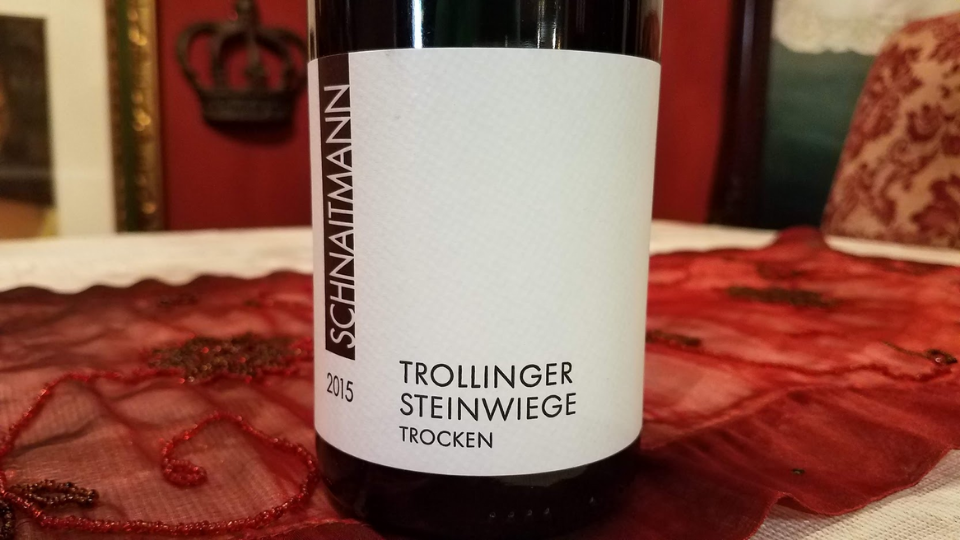HUMBLE BEGINNINGS
Trollinger is a vagabond grape carrying two passports, Italian and German, along with over three dozen identities. In its birthplace Alto Adige, Italy, it goes by the name Schiava, meaning slave grape. Perhaps overworked, it wandered over the border to Germany’s Wurttemberg state where it was given its present name and permanent residence. New to the area, I don’t think it was making much of a splash since the residents profiled it as a table grape, and gave it the name Black Hamburg. It doesn’t appear it was adjusting too badly when they associated it with the hamburger’s place of origin.
SHADOWBOXER WURTTEMBERG
Most consumers associate German wines to be sweet white wines. Well, brace yourself because ⅔ of all German wines are red and dry. The storied vineyard regions of the Mosel, Nahe, and Rheingau, that although clouds the Wurttemberg region by prestige, produces more wine out of the three. Did you know more wine is consumed in Württemberg per capita than anywhere else in Germany and twice as much as in the rest of Germany? It’s an underestimated special region and relatively undiscovered even in its own country. Its focus is mainly on the production of red wines. With its warm days and cool nights, red grapes develop layers of flavors that result in wines that are fresh, pure, and complex.
SWABIAN CHARISMA
Wurttemberg, what was once the medieval Duchy of Swabia in the 14th century. I’m sure Trollinger fell into a rave party when it became an accepted inhabitant by the natives. Like Gamay, it is made into a Fruit Loops style of wine, gulped traditionally by the locals soon after harvest without abandon. It was christened as the “Swabian National Drink”. I don’t believe that was much of an honor, but this next guy was able to rescue it from disgrace.
MAVERICK SCION
Today 19th generation Rainer Schinaitmann is keeping the traditions alive on the 60-acre estate, in his hometown of Fellbach. He rescued this mocked grape from its shadows and transformed it by giving it the same respect as his Pinot Noirs (aka Spatburgunder). He proudly created his label in 1997 using organic viticulture practices along with minimal winemaking intervention. And has been garnering accolades since. Schnaitmann Weingut hails from the historical state of Baden-Wurttemberg, famously known for the Black Forest. With 600 years of succeeding grape-growing family, the Schinaifraus may know a thing or two about making wine.
VDP
Rainer Schinaitmann’s highest achievement is being knighted into the VDP (Verband Deutscher Prädikats- und Qualitätsweingüter; aka Association of German Quality Wineries with special attributes). I’ll spare you the history and politics, but it’s unfortunate German wines historically have been pigeonholed into the “BLUE NUNN” category; sweet, low alcohol, and uninteresting wines. What’s thrilling is there’s an aggressive movement by private organizations such as the VDP, that is treating terroir-driven dry wines in Germany, as their crowning glory.
SCHNAITMANN TROLLINGER STEINWIEGE TROCKEN 2015
REVIEW
Tollinger was never a grape with ambition since it ripens late. Today, it is almost exclusively synonymous with Wurttemberg where it’s made itself at home with a unique expression unlike any other. Vast global production of popular varieties such as Pinot Noir is often diluted and ends up tasting the same as the next.
In the past, Trollinger was pale and overtly fruity and clumsy. However, the modern versions made by enthusiastic young winemakers, such as Rainer Schinaitmann, have the wines singing JT’s song “SexyBack”; exciting on the palate, fragrant on the nose, and utterly flexible, what a grape!
APPEARANCE
Light ruby with a transparent core and pinkish rim.
NOSE
The high intense red fruit of sour cherries, pomegranate, juicy raspberries, citrus kumquats, perfumed with dried hibiscus, fresh laurel, and savory tones of black pepper, and potting soil.
PALATE
Dry, pronounced acid, medium alcohol, medium- body, textured tannins, medium intensity, driven by red fruit, red berries, and red plum pith, followed by accents of cracked peppercorns, dried roses, orange tea, lifted by mineral sediment core, and long vivacious acid finish.
CONCLUSION
This a perfectly balanced wine, it satisfies the fruit aspect, aromatically sweet and spicy, solid earth tones, refrained alcohol, and refined tannins. Concentration is a juicy palate, with a bustling acid finish. I would serve this wine to enhance its personality slightly chilled. It’s generously food-friendly; think a tomato-based stew, or buttery Chilean sea bass, even a mandarine duck confit salad with a sesame dressing. Man, I’m hungry for such a player.
Next time you’re looking for a Pinot Noir alternative, look no further and savor a Trollinger from Schnaitmann Weingut. What do you think about making the Wurttemberg region your next hunting ground for distinctive reds?
Hope you enjoyed my reviews, please comment below Love your feedback.
Thank you and remember Taste Small Live Big!
Follow me on Instagram @epicurean.angel

